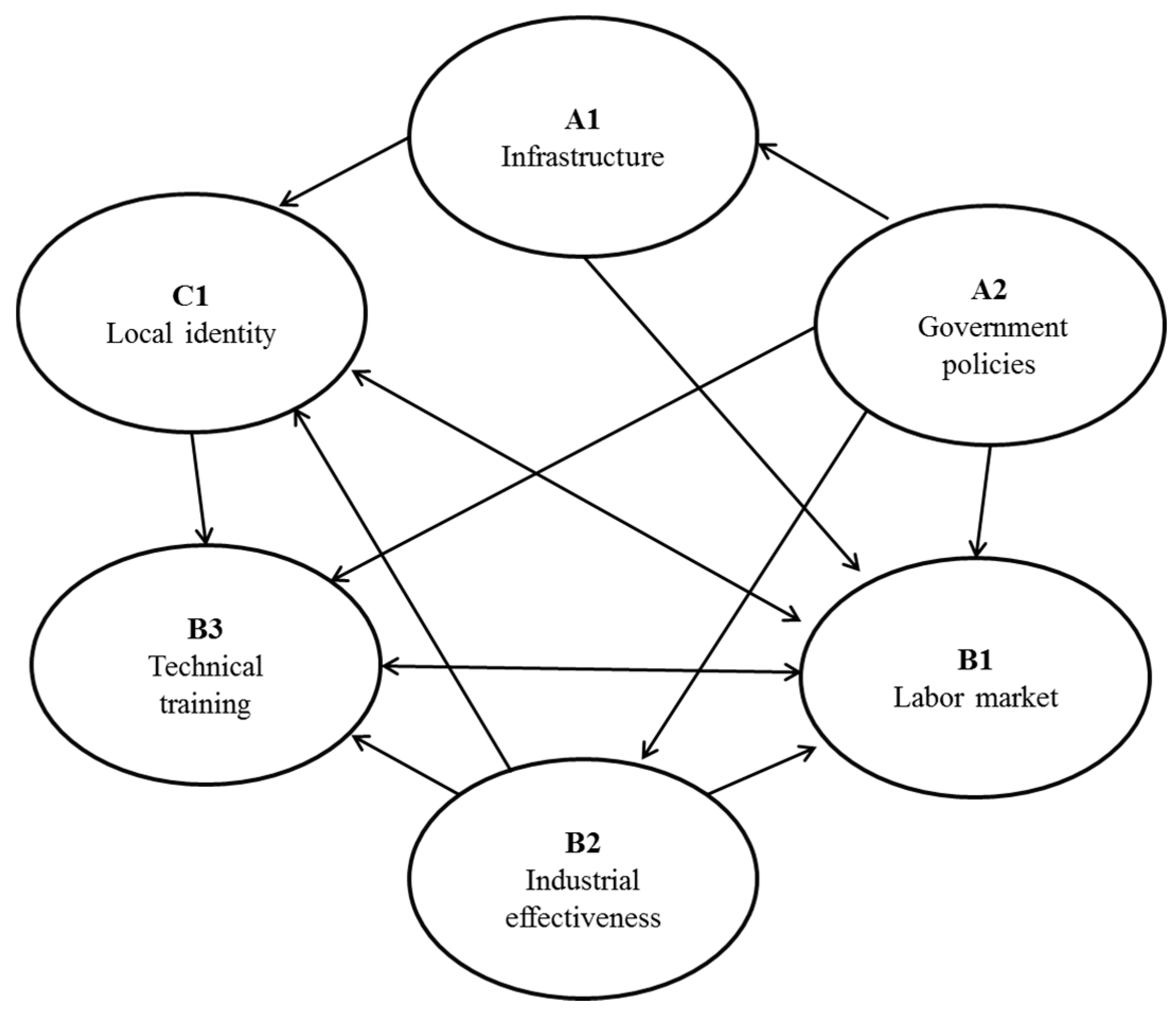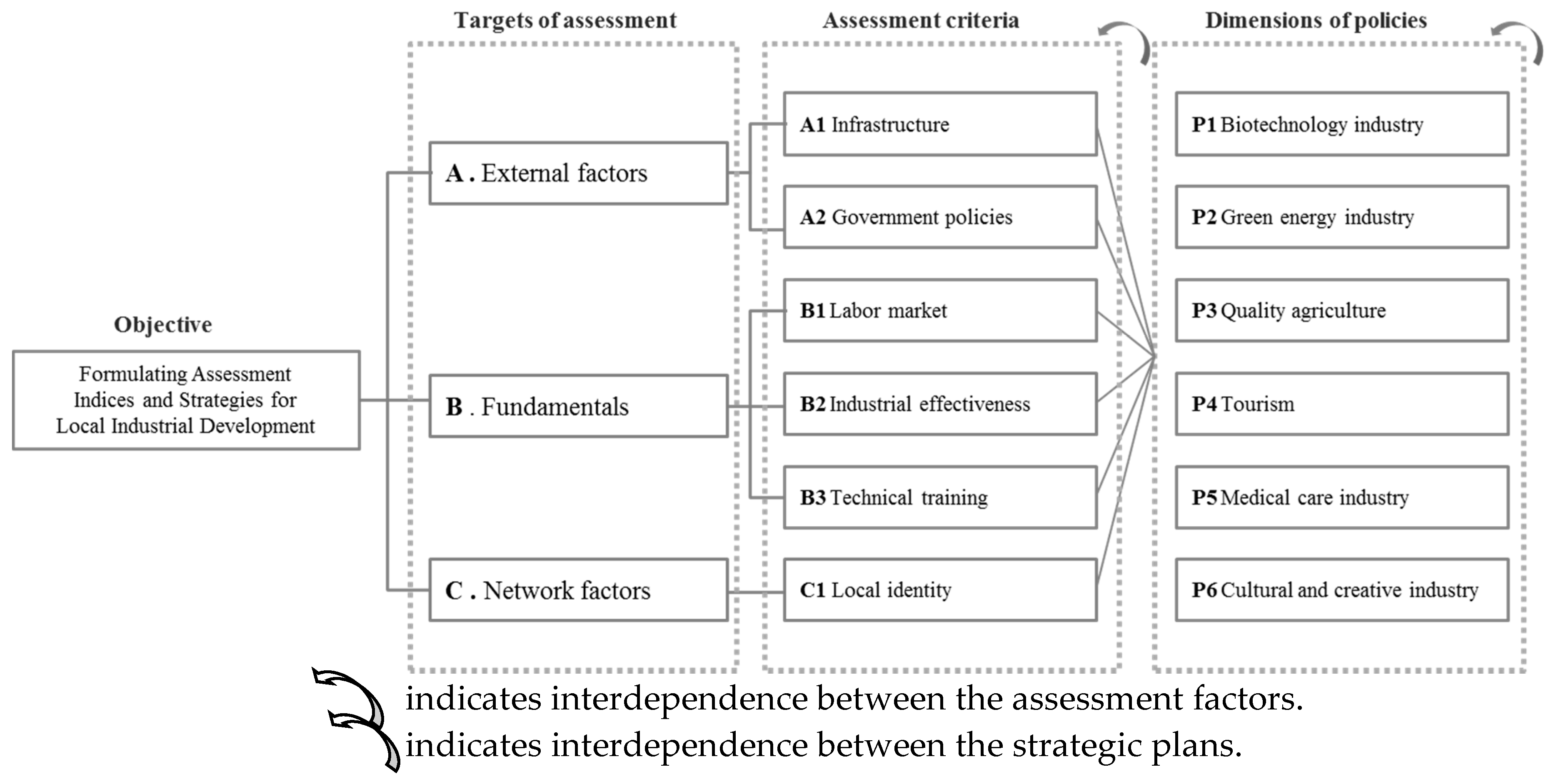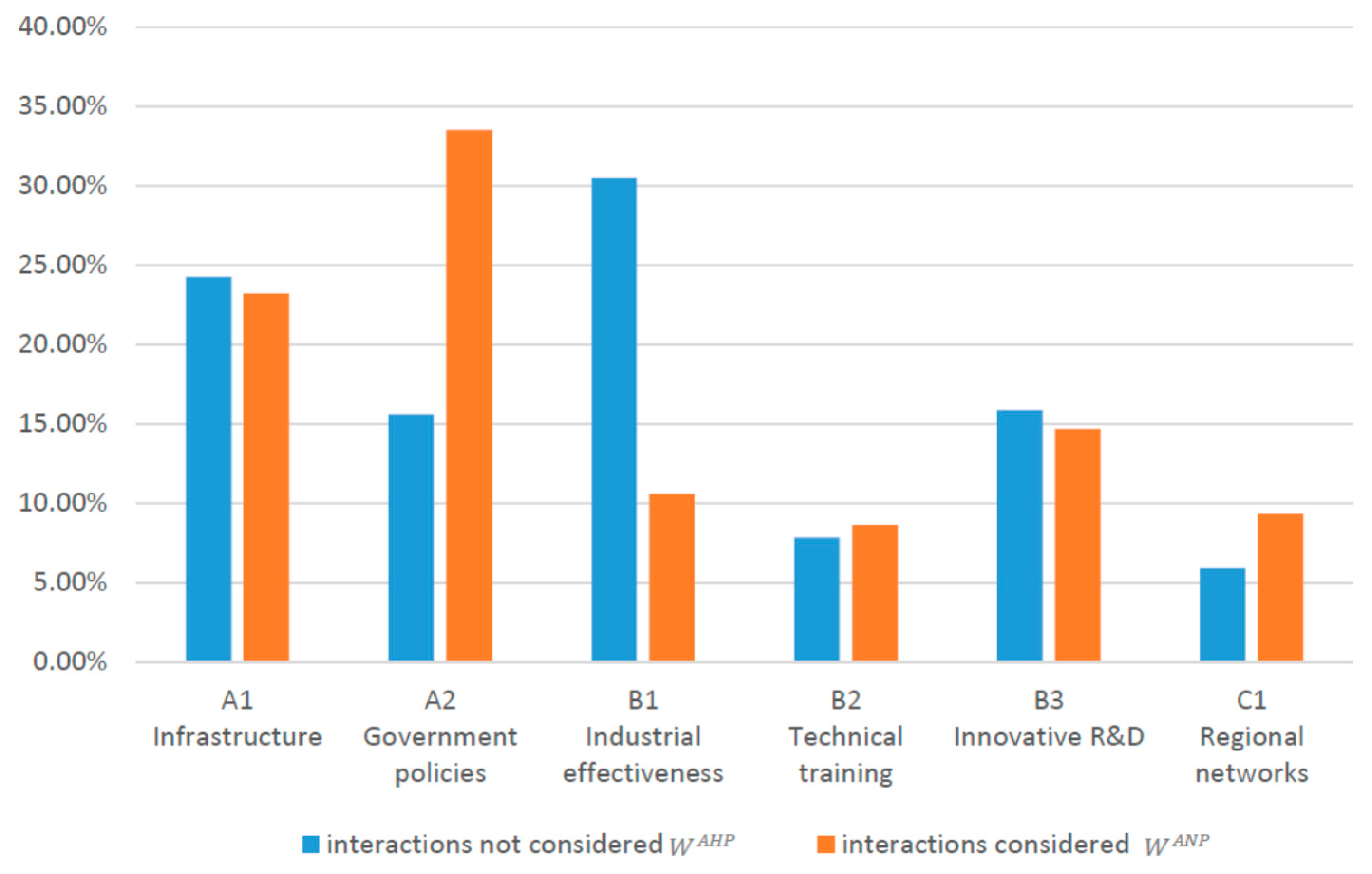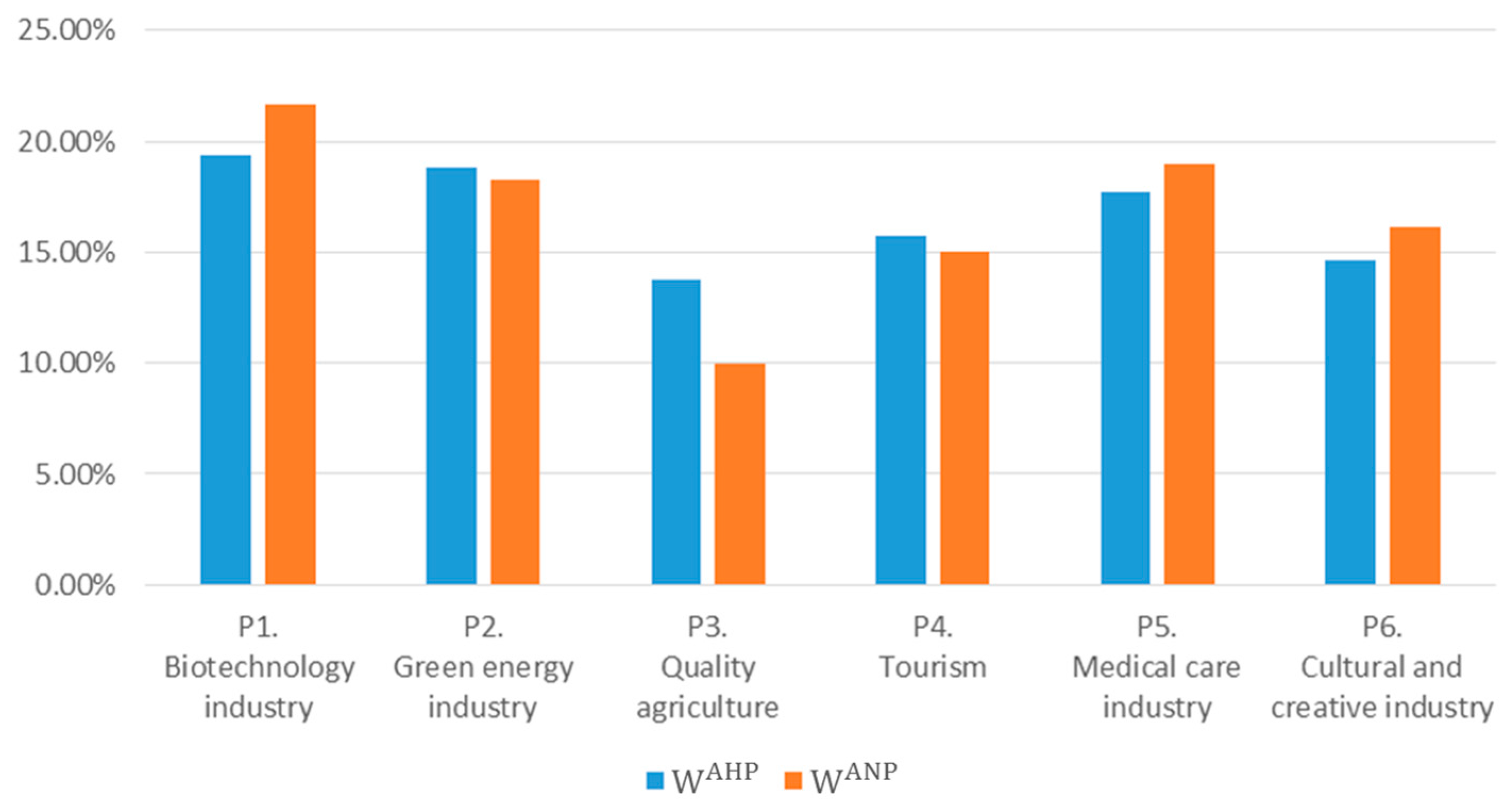Formulating Assessment Indices and Strategies for the Transition to Local Industrial Development in Taoyuan City, Taiwan
Abstract
:1. Introduction
2. Literature Review
2.1. Local Industrial Development
2.2. Local Industrial Development Indicators
3. Establishing Local Industrial Development Indicators
3.1. Local Industrial Development Indicators
3.2. Formulating Criteria and Indices for Assessing Local Industrial Development
- (1)
- (A1) Infrastructure: The integrity of the infrastructure in an area that supports the local industry’s global communication and circulation of information and people.
- (2)
- (A2) Government policies: The integrity of the support from national policies for an industry that facilitates local industries to expand or transform.
- (3)
- (A3) Economic performance: The macroeconomic performance of a country or region that affects the industrial development of the region.
- (4)
- (A4) Local resources: Whether or not an industry’s environment has special industrial and cultural resources, and whether or not the industry has taken advantages of these resources to reduce costs and produce economic benefits.
- (5)
- (B1) Labor market: Labor production capacity of the region where an industry is situated.
- (6)
- (B2) Industrial effectiveness: Contribution of an industry and if it increases added value.
- (7)
- (B3) Technical training: The cultivation and incubation of professional and versatile talents for the industries of an area.
- (8)
- (B4) Innovative R&D: Whether or not the internal operation of an industry has the capability to innovate and the mechanism to adjust production; industrial profits are incorporated as a factor for assessing industrial innovation.
- (9)
- (C1) Local identity: The positive and negative evaluations and the level of support from local residents for an industry.
- (10)
- (C2) Regional networks: Whether or not an industry is closely connected with local communities, and whether or not the industry’s development organizations have guided and financially supported the communities to gradually expand its businesses.
- (11)
- (C3) Location advantages: Whether or not the location and development direction of a local industry meets the demand of nearby cities, and the prospect of employment and economic growth of regional industries.
- (12)
- (C4) Marketing management: The establishment of local industry brands to facilitate industry promotion and marketing.
3.3. Questionnaire Results Based on the Fuzzy Delphi Method
4. Strategic Plans for Local Industries
4.1. Framework of the Strategic Plans for Local Industries
4.2. Determining Priorities for Local Industrial Strategies
4.3. Discussion on the Major Development Policies for Taoyuan City
5. Conclusions
5.1. Establishing the Development Indices for Local Industries
5.2. Formulating Action Plans for Local Industries
5.3. Establishing and Applying the Action Plans for Local Industrial Development
Acknowledgments
Author Contributions
Conflicts of Interest
References
- Liau, S.J.; Chou, T.L. The Primary Study of Local Development Institution Form in Taiwan: The Discussion of Some Northern Coastal Areas. J. Archit. Plan. 2000, 1, 13–34. [Google Scholar]
- Fan, S.M.; Chou, T.L. Local Development Strategies in Taiwan: Governance and Networking. J. City Plan. 2008, 35, 99–122. [Google Scholar]
- Barberia, L.G.; Biderman, C. Local economic development: Theory, evidence, and implications for policy in Brazil. Geoforum 2010, 41, 951–962. [Google Scholar] [CrossRef]
- Leidecker, J.K.; Bruno, A.V. Identifying and using critical success factors. Long Range Plan. 1984, 17, 23–32. [Google Scholar] [CrossRef]
- Ching, C.H.; Chou, T.L. Differentiations in Taiwan’s Regional Industrial Clusters: The Impacts of China Effects. J. Geogr. Sci. 2007, 49, 55–79. [Google Scholar]
- Small and Medium Enterprise Administration. White Paper on Small and Medium Enterprises; Small and Medium Enterprise Administration: Taipei, Taiwan, 2005. [Google Scholar]
- Council for Economic Planning and Development. Challenge 2008: National Development Plan (2002–2007); Council for Economic Planning and Development, Executive Yuan: Taipei, Taiwan, 2005. [Google Scholar]
- Taoyuan City Government. Taoyuan Aerotropolis Project. Available online: http://www.tycg.gov.tw/aerotropolis/ (accessed on 15 August 2015).
- Porter, P. Clusters and the new economics of competitiveness. Harv. Bus. Rev. 1998, 76, 77–90. [Google Scholar] [PubMed]
- Cooke, P.; Uranga, M.G.; Etxebarria, G. Regional systems of innovation: An evolutionary perspective. Environ. Plan. A 1998, 30, 1563–1584. [Google Scholar] [CrossRef]
- Cooke, P. Regional innovation system, clusters, and the knowledge economy. Ind. Corp. Chang. 2001, 10, 945–974. [Google Scholar] [CrossRef]
- Lin, K.F.; Hu, T.S.; Hsieh, H.N.; Chia, P.C. Industrial Cluster Formation and Evolution-The Case of Hsinchu Area. J. Archit. Plan. 2012, 13, 45–74. [Google Scholar]
- Yen, Y.C.; Kung, S.F. Identification of Horizontal Spatial Clustering and Its Spatial Structure: The Case of Manufacturing Industries in Taiwan. J. City Plan. 2014, 41, 117–148. [Google Scholar]
- Yung, Y.C.; Kung, S.G.; Wang, F.S. Industrial Development and Spatial Distribution of Regional Clusters in Southern Taiwan. J. Public Aff. Rev. 2009, 10, 109–145. [Google Scholar]
- Yu, C.L.; Lu, D.B.; Luo, M.S. The Study of Local Charm Industries Design Process: A Case Study of Baihe Lotus Industry. Baihe Lotus Industry. J. Archit. 2010, 72, 129–146. [Google Scholar]
- Chen, L.C. An Analysis on the Local Characteristic Industry in Taiwan. J. Chin. Trend Forw. 2007, 3, 81–98. [Google Scholar]
- Liau, S.J.; Chou, T.L. The Globalization and Taiwan’s Local Redevelopment Strategies. J. City Plan. 2000, 27, 191–209. [Google Scholar]
- Liau, S.J. Globalization, State Regulation and Local Development. J. City Plan. 2005, 32, 25–56. [Google Scholar]
- National Development Council. Six Emerging Industries. Available online: http://www.ndc.gov.tw/News.aspx?n=E641F7FF2AE058A1&sms=8B7FD77816422CEF (accessed on 17 August 2015).
- National Development Council. Five Innovative Industries. Available online: http://www.ey.gov.tw/policy9/cp.aspx?n=1EB1D1DD8C83B9C0 (accessed on 17 August 2015).
- Buckley, P.J.; Pass, C.L.; Prescott, K. Measures of international competitiveness: A critical survey. J. Mark. Manag. 1988, 4, 175–200. [Google Scholar] [CrossRef]
- Lee, H.T.; Yen, S.L. The Development of Miao-li Local-Characteristics Industry and Its Competitiveness Analysis. Yu Da Acad. J. 2006, 11, 49–74. [Google Scholar]
- Huang, C.J. Industry Planning of Organic Agriculture of Taiwan. Chin. J. Agribus. Manag. 1998, 4, 102–126. [Google Scholar]
- Coelli, T.J.; Prasada Rao, D.S.; O’Donnell, C.J.; Battese, G.E. Introduction Efficiency Productivity Analysis; Kluwer Academic Publishers: Dordrecht, The Netherlands, 1998. [Google Scholar]
- Yao, S.S.; Chiang, Y.S.; Wang, S.E. Total Factor Productivity Change and Effects of Production Environment in Taiwan. J. Plan. 2001, 28, 1–23. [Google Scholar]
- Dunning, J.H. The eclectic paradigm of international production: A restatement and some possible extensions. J. Int. Bus. Stud. 1988, 19, 1–31. [Google Scholar] [CrossRef]
- Taiwan Institute of Economic Research. Investigation of Characteristic Industry in Taipei Wanhua, Datong; Business Administration Commissioned Taipei: Taipei, Taiwan, 2001. [Google Scholar]
- Coelli, T.J.; Rao, D.S.P.; O’Donnell, C.J.; Battese, G.E. An Introduction to Efficiency and Production Analysis; Springer: New York, NY, USA, 2005. [Google Scholar]
- Jeng, T.-B. Fuzzy Assessment Model for Maturity of Software Organization in Improving its Staff's Capability. Master’s Thesis, Graduate Institute of Information Management, National Taiwan University of Science and Technology, Taipei, Taiwan, 2001. [Google Scholar]
- Wu, J.-Y.; Huang, Y.-S. The Establishment of Vulnerability Evaluation Indices: The Case of Shueili Township, Nantou, Taiwan. J. City Plan. 2011, 38, 195–218. [Google Scholar]
- Saaty, T.L. The Analytic Network Process; RWS Publications: Pittsburgh, PA, USA, 1996. [Google Scholar]




| Country | United States | Britain | Singapore | China | Korea | Hong Kong | Taiwan | |
|---|---|---|---|---|---|---|---|---|
| Industry | ||||||||
| Environmental protection | ◎ | ◎ | ◎ | ◎ | ◎ | ◎ | ◎ | |
| Innovative technology | ◎ | ◎ | ◎ | ◎ | ◎ | ◎ | ◎ | |
| Biomedicine | ◎ | ◎ | - | ◎ | ◎ | ◎ | ◎ | |
| Cultural and creative industry | ◎ | ◎ | - | ◎ | ◎ | ◎ | ◎ | |
| Educational training | ◎ | ◎ | ◎ | - | - | ◎ | - | |
| Tourism | ◎ | ◎ | ◎ | ◎ | ◎ | ◎ | ◎ | |
| High value-added manufacturing | ◎ | ◎ | ◎ | ◎ | ◎ | - | - | |
| Six Key Emerging Industries in 2009 | Five Plus Two Industries in 2016 | |
|---|---|---|
| Medicine | ◎ | ◎ |
| Biotechnology | ◎ | ◎ |
| Green energy | ◎ | ◎ |
| Agriculture | ◎ | ◎ |
| Tourism | ◎ | - |
| Cultural and creative industry | ◎ | - |
| Machinery | - | ◎ |
| National defense | - | ◎ |
| Aerospace | - | ◎ |
| Index Dimension Institute and Research | Economic Performance | Government Policies | Business Efficiency | Infrastructure | Innovative R&D | Industrial Performance | Humanities and Society | Technology and Techniques | Geographical Location | Natural Environment | Social Responsibility |
|---|---|---|---|---|---|---|---|---|---|---|---|
| International Institute of Management Development | ◎ | ◎ | ◎ | ◎ | |||||||
| World Economic Forum | ◎ | ◎ | ◎ | ◎ | ◎ | ||||||
| Global Urban Competitiveness Project | ◎ | ◎ | ◎ | ◎ | ◎ | ◎ | |||||
| UK Regional Competitiveness Index | ◎ | ◎ | ◎ | ◎ | ◎ | ||||||
| Lee and Yen (2006) [22] | ◎ | ◎ | ◎ | ◎ | |||||||
| Huang (1998) [23] | ◎ | ◎ | ◎ | ◎ | ◎ | ||||||
| Coelli et al. (2009) [28] | ◎ | ◎ | ◎ | ◎ | ◎ | ||||||
| Yao et al. (2001) [25] | ◎ | ◎ | |||||||||
| Dunning (2001) [26] | ◎ | ◎ | |||||||||
| Yu et al. (2010) [15] | ◎ | ◎ | ◎ | ◎ |
| Objective | Targets of Assessment | Criteria | Assessment Factors |
|---|---|---|---|
| Criteria for assessing local industrial development | External factors | A1 Infrastructure | A1-1 Convenience afforded by infrastructure and transportation networks |
| A1-2 Density and integrity of industrial platforms | |||
| A1-3 Soundness of international network communication equipment and platforms | |||
| A1-4 Quality of supply (e.g., energy) | |||
| A2 Government policies | A2-1 Soundness of laws and regulations for promoting industries | ||
| A2-2 Incentives and preferential policies for industrial development | |||
| A2-3 Integrity of counseling and financing funds | |||
| A2-4 Incentives and counseling for industrial transformation and upgrade | |||
| A2-5 Flexibility in national land control and land cost | |||
| A3 Economic performance | A3-1 Gross domestic product (GDP) | ||
| A3-2 Ratio of each industry to GDP | |||
| A3-3 Ratio of trade to GDP | |||
| A3-4 Ratio of international investment | |||
| A3-5 Interest rates and business tax rate | |||
| A4 Local resources | A4-1 Regional natural and tourist resources | ||
| A4-2 Locally characteristic customs, cultures, and arts | |||
| A4-3 Locally characteristic historic sites and buildings | |||
| A4-4 Maintenance of urban landscapes and environmental quality | |||
| A4-5 Cost of regional resource utilization | |||
| Fundamentals | B1 Labor market | B1-1 Proportion of labor productivity | |
| B1-2 Flexibility in wages and salaries | |||
| B1-3 Ability to attract and retain talents | |||
| B2 Industrial effectiveness | B2-1 Ratio of industrial production to market demand | ||
| B2-2 Soundness of industrial clusters | |||
| B2-3 Integrity of industrial value chains and work specialization | |||
| B2-4 Scale and number of industries | |||
| B2-5 Network among industries | |||
| B2-6 Industrial development potential | |||
| B3 Technical training | B3-1 Industry-government-academia cooperation and integration | ||
| B3-2 Soundness of professional education systems | |||
| B3-3 Development and training of professional and versatile talents | |||
| B3-4 Sufficient institutions for developing specialized talents | |||
| B4 Innovative R&D | B4-1 Service innovation, process innovation, and industrial innovation | ||
| B4-2 Investment in industrial R&D | |||
| B4-3 Number of patents | |||
| B4-4 Intellectual property and transfer | |||
| Network factors | C1 Local identity | C1-1 Identification with local industries | |
| C1-2 Participation and investment in local industries | |||
| C1-3 Emerging industries’ degrees of tolerance and acceptance | |||
| C2 Regional networks | C2-1 Public and private partnerships | ||
| C2-2 Regional development cooperation platforms | |||
| C2-3 Regional cultural elements | |||
| C2-4 Assistance from related local associations | |||
| C2-5 Links between professional communities and local places | |||
| C3 Location advantages | C3-1 Facilitating the development of neighboring industries | ||
| C3-2 Location quotient | |||
| C3-3 Shift share | |||
| C3-4 Demand of nearby cities | |||
| C4 Marketing management | C4-1 Establishment of local industrial brands | ||
| C4-2 Cross-industry alliance | |||
| C4-3 Local image marketing |
| Assessment Indices | Minimum Ci | Maximum Oi | Singular Value a | Geometric Mean | Test Value Zi | Expert Consensus Gi | Selection > 6.35 | |||||
|---|---|---|---|---|---|---|---|---|---|---|---|---|
| min | max | min | max | min | max | Ci | Oi | Singular Value | ||||
| A1 Infrastructure * | 4 | 6 | 8 | 10 | 5 | 6 | 5.14 | 8.56 | 6.72 | 5.42 | 6.85 | Yes |
| A2 Government policies * | 5 | 7 | 8 | 10 | 6 | 9 | 6.15 | 9.36 | 7.53 | 4.21 | 7.76 | Yes |
| A3 Economic performance | 3 | 5 | 5 | 8 | 4 | 7 | 4.13 | 7.09 | 5.88 | 2.96 | 5.61 | No |
| A4 Local resources | 3 | 5 | 6 | 7 | 5 | 6 | 3.73 | 6.58 | 5.38 | 3.85 | 5.15 | No |
| B1 Labor market | 3 | 6 | 5 | 8 | 4 | 7 | 4.68 | 7.28 | 5.67 | 1.6 | 5.63 | No |
| B2 Industrial effectiveness * | 6 | 8 | 8 | 10 | 7 | 9 | 6.55 | 9.17 | 7.76 | 2.61 | 7.86 | Yes |
| B3 Technical training * | 4 | 6 | 6 | 9 | 5 | 7 | 4.96 | 7.92 | 6.35 | 2.96 | 6.44 | Yes |
| B4 Innovative R&D * | 4 | 8 | 7 | 10 | 6 | 9 | 5.62 | 8.52 | 6.89 | 1.9 | 7.39 | Yes |
| C1 Local identity | 3 | 6 | 5 | 10 | 4 | 8 | 3.96 | 7 | 5.62 | 2.04 | 5.49 | No |
| C2 Regional networks * | 4 | 6 | 7 | 9 | 6 | 7 | 4.74 | 7.95 | 6.38 | 4.21 | 6.35 | Yes |
| C3 Location advantages | 3 | 6 | 6 | 8 | 5 | 7 | 4.28 | 7.35 | 5.97 | 3.07 | 5.82 | No |
| C4 Marketing management | 2 | 6 | 4 | 8 | 3 | 7 | 3.44 | 6.58 | 5.12 | 1.14 | 5 | No |
| Total number of selected factors: 12 | Threshold | 6.35 | ||||||||||
| Crucial Assessment Indices Passing the Threshold of 6.35 | Assessment Indices Failing to Pass the Threshold of 6.35 | ||||
|---|---|---|---|---|---|
| Rankings | Assessment Factors | Expert Consensus Gi | Rankings | Assessment Factors | Expert Consensus Gi |
| 1 | B2 Industrial effectiveness | 7.86 | 7 | C3 Location advantages | 5.82 |
| 2 | A2 Government policies | 7.76 | 8 | B1 Labor market | 5.63 |
| 3 | B4 Innovative R&D | 7.39 | 9 | A3 Economic performance | 5.61 |
| 4 | A1 Infrastructure | 6.85 | 10 | C1 Local identity | 5.49 |
| 5 | B3 Technical training | 6.44 | 11 | A4 Local resources | 5.15 |
| 6 | C2 Regional networks | 6.35 | 12 | C4 Marketing management | 5 |
| Rankings of Importance | Weights of Local Industry Indices () | Weights of Local Industry Indices () | ||||
|---|---|---|---|---|---|---|
| Item | Weight | % | Item | Weight | % | |
| 1 | B1 Industrial effectiveness | 0.30521 | 30.52% | A2 Government policies | 0.335405 | 33.54% |
| 2 | A1 Infrastructure | 0.24257 | 24.26% | A1 Infrastructure | 0.232297 | 23.23% |
| 3 | B3 Innovative R&D | 0.15863 | 15.86% | B3 Innovative R&D | 0.146929 | 14.69% |
| 4 | A2 Government policies | 0.15609 | 15.61% | B1 Industrial effectiveness | 0.105945 | 10.59% |
| 5 | B2 Technical training | 0.07838 | 7.84% | C1 Regional networks | 0.093442 | 9.34% |
| 6 | C1 Regional networks | 0.05912 | 5.91% | B2 Technical training | 0.085983 | 8.60% |
| Rankings of Importance | Weights of Local Industrial Development Strategies () | Weights of Local Industrial Development Strategies () | ||||
|---|---|---|---|---|---|---|
| Item | Weight | % | Item | Weight | % | |
| 1 | P1 Biotechnology industry | 0.19347 | 19.35% | P1 Biotechnology industry | 0.21629 | 21.63% |
| 2 | P2 Green energy industry | 0.18813 | 18.81% | P5 Medical care industry | 0.18994 | 18.99% |
| 3 | P5 Medical care industry | 0.17691 | 17.69% | P2 Green energy industry | 0.18246 | 18.25% |
| 4 | P4 Tourism | 0.15771 | 15.77% | P6 Cultural and creative industry | 0.16105 | 16.11% |
| 5 | P6 Cultural and creative industry | 0.14628 | 14.63% | P4 Tourism | 0.15053 | 15.05% |
| 6 | P3 Quality agriculture | 0.13751 | 13.75% | P3 Quality agriculture | 0.09973 | 9.97% |
© 2017 by the authors. Licensee MDPI, Basel, Switzerland. This article is an open access article distributed under the terms and conditions of the Creative Commons Attribution (CC BY) license ( http://creativecommons.org/licenses/by/4.0/).
Share and Cite
Pan, Y.-C.; Chiu, Y.-H. Formulating Assessment Indices and Strategies for the Transition to Local Industrial Development in Taoyuan City, Taiwan. Sustainability 2017, 9, 364. https://doi.org/10.3390/su9030364
Pan Y-C, Chiu Y-H. Formulating Assessment Indices and Strategies for the Transition to Local Industrial Development in Taoyuan City, Taiwan. Sustainability. 2017; 9(3):364. https://doi.org/10.3390/su9030364
Chicago/Turabian StylePan, Yung-Cheng, and Yin-Hao Chiu. 2017. "Formulating Assessment Indices and Strategies for the Transition to Local Industrial Development in Taoyuan City, Taiwan" Sustainability 9, no. 3: 364. https://doi.org/10.3390/su9030364
APA StylePan, Y.-C., & Chiu, Y.-H. (2017). Formulating Assessment Indices and Strategies for the Transition to Local Industrial Development in Taoyuan City, Taiwan. Sustainability, 9(3), 364. https://doi.org/10.3390/su9030364





